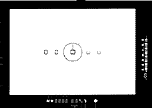Demo only - developer/contributors preview
Exposure Control Methods The Canon EOS-1n's automatic exposure modes are virtually the same as the original EOS-1. But since my earlier EOS-1 effort was not as detail, so, I will make use of this site to patch issues that were not well addressed or specified. With all the available Metering Systems (Six (6) Metering Modes) as its backbone, Exposure Control in the Canon EOS-1N is equally impressive with its long list of possibilities (basic formation of six auto exposure modes. With real time exposure compensation, program shifting, and flash exposure compensation and other secondary feature, the exposure can be set according to your requirements). If you are confused, don't be. It can be just grouped under AUTO, MANUAL and various Auto-FLASH exposure fine-tuning modes.
 |
|
This technological marvel from Canon is capable to deliver multiple means in assisting the photographer to use any preferred choice as well as further fine-tuning an exposure - regardless of how tricky is the situations. Sections will be discussed in this section are: Intelligent Programmed AE ("P"), Shutter Priority AE ("Tv"), Aperture Priority AE ("Av"), Auto Exposure Lock ("AE-L"), Depth of Field AE ("DEP"), Exposure Compensation, Auto Exposure Bracketing ("AEB"), Manual Exposure Control ("M"), Multiple Exposures, A-TTL Automatic Flash Exposure, TTL Automatic Flash Exposure, Flash Exposure Compensation; Normal Bulb Exposure control, Self Timer Operation as well as the all important Shutter Mechanism. As mentioned, most basic forms are available in the previous Canon EOS-1 but this replacement model has added a few extra functions, improved and refined further in a few common areas. If the above listing is too confuse, let me outlined them orderly in the chart:-
Exposure control can be carried out in the following seven modes (other secondary features not mentioned.
| 1. Shutter-priority AE | Shutter speed and aperture settings were made in 1/3-stop increments. But a custom function for making settings in 1-stop or 1/2-stop increments was also available. | |
| 2. Aperture-priority AE | ||
| 3. Program AE | Intelligent type. Shiftable. | |
| 4. Depth-of-field AE | The, depth was measured with the central focusing point in the case of automatic focusing point selection or with the selected focusing point in the case of manual focusing point selection. | |
| 5. A-TTL automatic flash | The EOS-1N's unique control method under the A-TTL program. | |
| 6. TTL automatic flash | The EOS-1N's unique control method under the TTL program. | |
| 7. Manual exposure | Metered manual. 1/3-stop display. A custom function providing a 1/2-stop display was also available. |
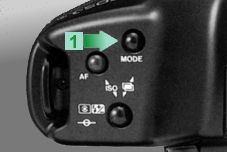 |
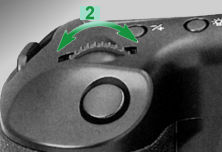 |
Operational Sequence in navigating or selecting a particular shooting mode: - 1. While pressing the shooting mode selector, turn the Main Dial and select the exposure mode. 2. When the desired exposure mode shows on the LCD, release the shooting mode selector to register the selection. The following section may just use a simplified illustration to improve download time. |
NOTE:- Exposure modes are shown in a loop sequence (it is reversible): P (program AE -->> Av (aperture-priority AE) --->> DEP (depth-of-field AE) --->> M (manual exposure) --->> Tv (shutter speed-priority AE --->> bulb.--->> Back to Program (P) again and so forth..
a) Automatic Exposure Control (Relative:- Basic Info on Exposure) As the EOS-1N is essentially a fully electronic camera, majority of the exposure control modes are inclined for automatic exposure control but other than automated functions, it also offers full manual exposure control (the manual here is not referring to Mechanical means). Other than the options, the key highlights of the exposure control system in the EOS-1n is its ability to permit photographer adjusts and fine-tuning exposure in 1/3, 1/2 or full EV stops, while the camera offers real-time exposure control: either automatic or manual. Besides, Five focusing points provide a wide focusing area, making it easy to try out various picture compositions. As mentioned earlier, although the basic EOS-1N's exposure control system is almost similar to EOS-1's. But you can choose, override and alter the AE mode's exposure setting at any time. The difference in its real-time exposure control allows photographer to set the final exposure setting (it even applies to its AF system as well). With the wide range of options, anyone can choose the exposure mode according to the subject and shooting conditions. With real-time exposure compensation and flash exposure compensation, you can adjust the exposure to obtain the desired photographic effects. Further, a newly added feature to the EOS-1N's exposure control system is, it now enables the shutter speed and aperture setting to be adjusted in 1/2 stops, in addition to the 1/3 and full stops enabled by the previous model, Canon EOS-1. This addition provides a higher degree of control for auto exposure bracketing, etc.
Anyway, although Canon EOS-1n has a rather wide exposure range in various AE modes, but still, other variable factors (such as slow lens speed, low light shooting conditions etc.) may limit its effective working range in exposure calculations for proper exposure execution, below outlines a rough guide for these limitations. Should you have any visual alert with any of the automatic exposure modes, you can use here as a visual comparison references:-
Maximum
permissible working Range & Exposure
Warnings in Various
AE Modes with the EOS-1n Series Models Note:- Numbers enclosed
by a dotted line blink
at 2Hz.
|
Shooting
conditions/ |
Low brightness |
Correct
exposure indication |
High brightness |
||||
|
Underexposure warning |
Overexposure warning |
||||||
|
A |
Tv AE |
Tv set |
Av auto |
Tv set |
Av auto |
Tv set |
Av auto |
|
Av AE |
Tv auto |
Av set |
Tv auto |
Av set |
Tv auto |
Av set |
|
|
Program AE |
Tv auto |
Av auto |
Tv auto |
Av auto |
Tv auto |
Av auto |
|
DEPTH: Using 50mm f/1.4 lense - ISO 100
|
Shooting
conditions/ |
Low brightness |
Correct exposure |
High brightness |
|||||
|
Underexposure warning |
Depth warning |
Overexposure warning |
||||||
|
Depth |
Tv auto |
Av auto |
Tv auto |
Av auto |
|
|
Tv set |
Av auto |
METERED MANUAL: Using 50mm f/1.4 - ISO 100
|
|
Manual |
Under exposure warning |
Correct exposure |
Over exposure warning |
|||
|
Tv set |
Tv set |
Tv set |
Exposure related Warnings
and Counter measures in EOS-1N Various Shooting Modes:- Exposures using the
functions of the basic EOS-1N camera, without flash.
|
Type of warning |
Warning indications |
Countermeasures for respective warnings |
||||
|
TV warnings |
AV warnings |
|||||
Under exposure warnings |
|
|
|
(1) |
Use flash or artificial lighting; (2)Use a higher speed film; (3) Give up the photograph. | |
|
Tv set |
|
|
(1) |
Set a slower shutter speed until the aperture value stops blinking. | ||
|
|
Av set |
|
(1) |
Open the aperture until the shutter speed stops blinking | ||
|
Tv set |
Av set |
|
(1) |
Open the aperture or (2) Set
a slower shutter speed, until the |
||
| Over exposure warnings |
|
|
|
(1) |
Use an ND filter. (2) Use a lower speed film. (3) Give up the photograph. | |
|
Tv set |
|
|
(1) |
Set a fester shutter speed until the aperture value stops blinking. | ||
|
|
Av set |
|
(1) |
Close the aperture until the shutter speed stops blinking | ||
|
Tv set |
Av set |
|
(1) |
Close the aperture or (2) set
a faster shutter speed, until the |
||
| DEPTH warnings |
|
|
|
(1) |
Expected depth of field. cannot be obtained.---->>> Use a higher speed film or (2) give up the DEPTH mode exposure. | |
| Exposures using flash: EOS-1N + 540EZ/430EZ The following warning is added to the above warnings in [1]. | ||||||
| Flash synchronization speed high-speed limit warning |
|
Av set |
|
(1) |
Close the aperture until "
|
|
Note: 1) ![]() Numbers
enclosed by a dotted line blink at 2Hz
Numbers
enclosed by a dotted line blink at 2Hz
2) AV 0 represents the maximum aperture of the lens and AV min represents
the minimum aperture of the lens.
3) TV set and AV set stand for the shutter speed and aperture value, respectively,
manually set by the user,
4) TV auto and AV auto represent the shutter speed and aperture value, respectively,
automatically calculated and set by the camera.
i) Intelligent Program AE (P)
Programmed AE control mode has been made like a standard feature in virtually all modern SLR cameras. The main reason probably is due to the elevated confident level of photographer given by today's advance metering system, which usually will yield good result for any given scene, so the trouble-free auto-exposure mode provides precise and responsive shooting without the hassle of other camera adjustments. Program AE mode usually will just compute with an optimum combination of shutter speed and aperture for an exposure. Since the interface between lens and camera is electronic now with the EOS system, it is possible to relay information so as to make the program AE mode a little bit "intelligent" as the program line changes in accordance with the focal length of the lens in use. Although intelligent program AE mode has been available for some time (I think the MF FD-mount Canon T70 of 1984 was the first Canon), but generally older camera models (esp. the manual focus electronic SLR cameras) can only work with fixed focal length optics. The immense popularity of zoom lenses today with ability to constantly changing of focal length can be also made possible in EOS/EF combination. In this case, the camera sets the proper exposure with an optimum shutter speed and aperture suiting the subject's brightness with the added benefit of taking the focal length of the lens in use into consideration. The main objective is, when light level is not as desirable, this advance AE mode will minimize chances of camera shake which might cause image blur due to choice of slow shutter speed during shooting. Further, even after the camera sets the proper exposure, you can still easily alter (program shift) the shutter speed and aperture combination to suit your requirements with your EOS-1N.
 |
|
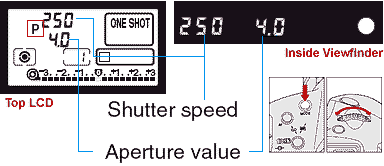 |
Operation: 1 Turn on the main switch. 2 Press the shooting mode selector while turning the main dial until “P” appears in the LCD panel. 3 Look through the viewfinder and ensure your subject of interest covers by one of the five focusing points, then press the shutter button halfway to focus it. When the subject is focused, the AF frame used for focusing temporarily lights red and the in-focus indicator lights up in the viewfinder in One-shot AF mode. If the in-focus indicator blinks, the autofocus system cannot focus the subject and the shutter will not release. In some extreme cases that may cause exposure error (like too dark of a given scene or too bright, making the out of range reading) consider focuses the subject manually. In most cases, exposure settings will be displayed in the LCD panel and inside the viewfinder. 4. After confirming that the exposure settings are not blinking, press the shutter button completely to take the picture. Just that simple. |
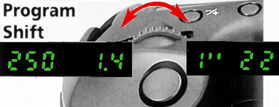 |
 |
Program shift with the Main Dial. While pressing the shooting mode selector, turn the Main Dial until "P" shows on the LCD. User can change the shutter speed and aperture combination set automatically by the program while maintaining correct exposure. This nature is called program shift. Press the shutter button halfway and turn the Main Dial to select the shutter speed and aperture combination. |
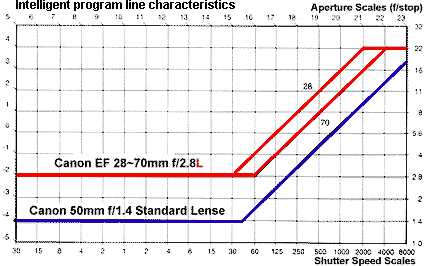 |
To prevent camera shake, the program automatically changes the program line and sets the shutter speed equivalent to the reciprocal of the focal length of the lens in use. For example, when a 50mm lens is used, the shutter speed is set to 1/50 sec. and the maximum aperture determines the EV limit; If the lighting conditions are less favorable or darker than this limit, the fastest usable shutter speed is set with maximum aperture. For another instance, when a 28-70mm f/2.8 zoom lens is set at 28mm, the shutter speed will be set to 1/30 sec. At focal length of 70mm, it will be set to 1/60 sec. The lens' focal length is detected in real time and the appropriate shutter speed is set. In such case, the program is actually designed to minimize camera shake which helps to achieve higher rate of successful photography. |
| previous | NEXT | Shutter Priority AE and Aperture Priority AE Mode
| Questions, Issues
& Answers
| Canon
EOS-1 Series Message
Board
|
Canon
EF lens Board
| in
a shared environment
|
Free Trade Zone |
shared
environment
| Back | Index Page The Canon EOS-1N
Series Professional SLR camera
|
Back | Main Index Page The Canon EOS-1
Series Professional SLR camera
Background and Various Issues
| The Basic
Features &
various Setup
Manual &
Auto Focusing |
Metering Systems | Exposure Control | Viewfinder
Optical
System Flash Photography (with Speedlite 540EZ extension & Selective info on Canon TTL Flash Models:-160E | 200E
| 300EZ | 300TL
| 420EZ | 430 EZ | 480EG | Macrolite
| Other non-TTL Canon flash model
Reliability Issues:- Body Chassis | Shutter Unit | Electronic Circuitry | Film Transport & film handling Secondary Functions:- Custom Function Part One | Part Two | System Accessories:- Film Back Options - instruction for Command Back E1 | Macro/Close Up Part one | Part two and Part III Flash for Macro-Photography | Power Sources -BP-E1 | PDB-E1 | Focusing Screens | Remote Control with Wireless Remote Set LC-3 | System compatibility
Variants of Canon EOS-1N:- Canon EOS-1N RS | Canon/Kodak Digital DCS-1, 3 -5 & 520/560 Series | Full Technical Specification | Main
Reference Map / Nomenclature
| Resource Centre:- Comparative Charts between EOS-1 &
EOS-1N / or with
its active Competition(s) (Nikon); Quick Operational Reference Card (278k Gif File);
Listings of 7-segment
digital numbers/letters
appeared on LCD display panel/viewfinders (HTML page); External Link:-Instruction Manual (3.3MB
PDF file applicable for both Canon
EOS-1N (RS). | Using EOS system for your photography | Bots & Nuts of EOS System - by Philip Chong |
The Eyes of EOS -
EF Lenses
A little OFF-TOPIC SOME Personal Thought
HOME - Photography in Malaysia |
Volunteered Maintainer(s) for the Canon EOS-1N Series Message Board: Philip Chong, Editor, Digital Camera Magazine; Vincent Thian, Photo Editor, Malaysian Bureau, Associated Press "AP", CYleow, Ex-photo Editor of local daily, The Star; Gary Rowan Higgins, Australia and other nice folks on the web.
Special Credit:- :Mr. Richard Yeow & Mr. Simon Wong from camera division of ![]() Marketing Malaysia, for their continual effort in
supporting development of this EOS/EF website. Others: All the nice people on earth who have contributed
their photos and pictures of personal works or product shots for the creation of
this site. Certain content and images appeared in this site were either scanned
from official marketing leaflets, brochures published by Nikon and/or contribution
from surfers who claimed originality of their own work for public publishing in this
website, where majority of the extracted information are used basing on educational
merits. The creator of this site will not be responsible for any discrepancies that
may arise from any possible dispute except rectifying them after verification from
respective source. Neither Nikon or its associates has granted any permission(s)
in using their public information nor has any interest in the creation of this site.
"Canon", "EOS",
"EF" "RT", "EOS-1n RS", "Booster
", "Macrolite", "fluorite", "Image Stabilizer"
& other applicable technical/business terms are registered trade name(s) of Canon
Inc., Japan. Site made with an Apple G5 IMac.
Marketing Malaysia, for their continual effort in
supporting development of this EOS/EF website. Others: All the nice people on earth who have contributed
their photos and pictures of personal works or product shots for the creation of
this site. Certain content and images appeared in this site were either scanned
from official marketing leaflets, brochures published by Nikon and/or contribution
from surfers who claimed originality of their own work for public publishing in this
website, where majority of the extracted information are used basing on educational
merits. The creator of this site will not be responsible for any discrepancies that
may arise from any possible dispute except rectifying them after verification from
respective source. Neither Nikon or its associates has granted any permission(s)
in using their public information nor has any interest in the creation of this site.
"Canon", "EOS",
"EF" "RT", "EOS-1n RS", "Booster
", "Macrolite", "fluorite", "Image Stabilizer"
& other applicable technical/business terms are registered trade name(s) of Canon
Inc., Japan. Site made with an Apple G5 IMac.
